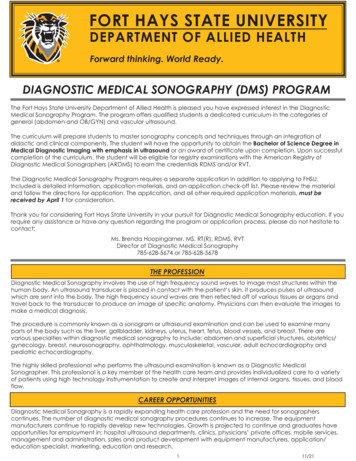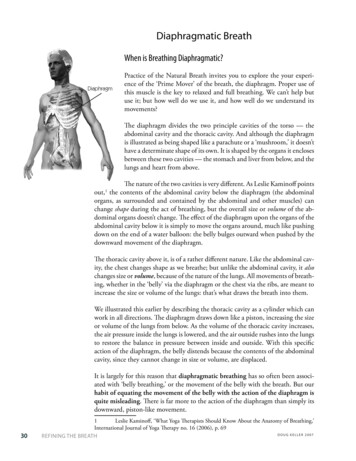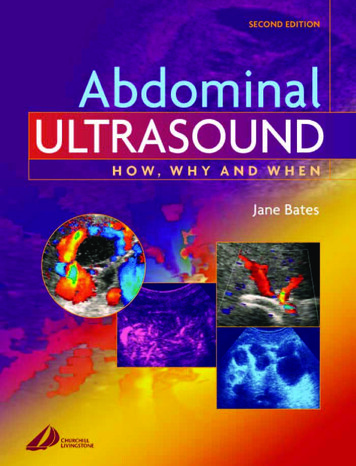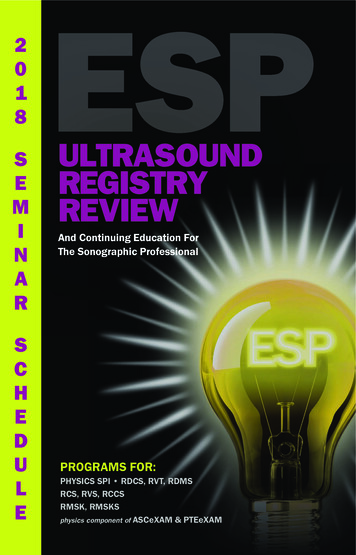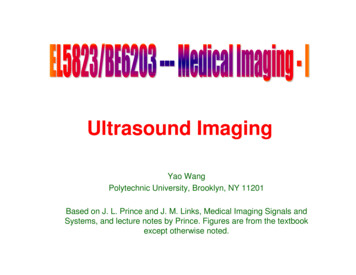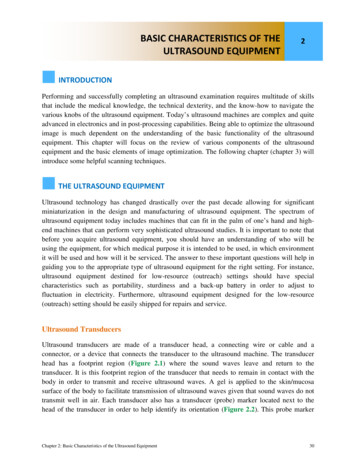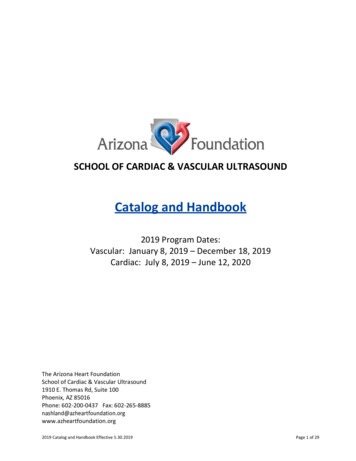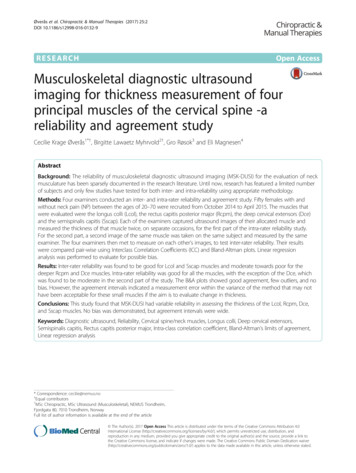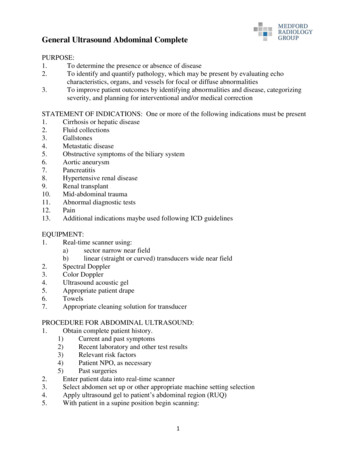
Transcription
General Ultrasound Abdominal CompletePURPOSE:1.To determine the presence or absence of disease2.To identify and quantify pathology, which may be present by evaluating echocharacteristics, organs, and vessels for focal or diffuse abnormalities3.To improve patient outcomes by identifying abnormalities and disease, categorizingseverity, and planning for interventional and/or medical correctionSTATEMENT OF INDICATIONS: One or more of the following indications must be present1.Cirrhosis or hepatic disease2.Fluid collections3.Gallstones4.Metastatic disease5.Obstructive symptoms of the biliary system6.Aortic aneurysm7.Pancreatitis8.Hypertensive renal disease9.Renal transplant10.Mid-abdominal trauma11.Abnormal diagnostic tests12.Pain13.Additional indications maybe used following ICD guidelinesEQUIPMENT:1.Real-time scanner using:a)sector narrow near fieldb)linear (straight or curved) transducers wide near field2.Spectral Doppler3.Color Doppler4.Ultrasound acoustic gel5.Appropriate patient drape6.Towels7.Appropriate cleaning solution for transducerPROCEDURE FOR ABDOMINAL ULTRASOUND:1.Obtain complete patient history.1)Current and past symptoms2)Recent laboratory and other test results3)Relevant risk factors4)Patient NPO, as necessary5)Past surgeries2.Enter patient data into real-time scanner3.Select abdomen set up or other appropriate machine setting selection4.Apply ultrasound gel to patient’s abdominal region (RUQ)5.With patient in a supine position begin scanning:1
General Ultrasound Abdominal Complete1)2)3)4)5)AORTA:a) In sagittal, view the proximal, mid, and distal aorta. Then transverse viewsdocumenting AP and transverse measurements.PANCREAS:a) Place the transducer just below the xiphoid process, and use the left lobe ofthe liver as an acoustic window. View the long axis of the body of thepancreas. The image should be oriented obliquely, as dictated by the patientanatomy, to show as much of the entire pancreatic anatomy as possible. Alsoidentify the pancreas head, uncinate process, and tail.b) Check pancreatic duct for dilatation and measure the diameter if dilated.c) Include the superior mesenteric vein when viewing the pancreatic head, aswell as the distal common bile duct.d) Document the pancreatic tail. Check peripancreatic region for adenopathy,and/or fluid.e) If bowel gas obstructs the view, administration of water may be helpful. Also,patient can hold breath to optimize visualization.LIVER:a) In sagittal, start midline and scan lateral (left of the patient), demonstrating theleft lobe of the liver and its parenchyma, as well as the aorta, and body of thepancreas.b) Scan back to midline, then angle to the right to visualize the right lobe of theliver, including the position of the IVC where it passes through the liver.Identify the main portal vein, common bile duct, and hepatic artery.Demonstrate as much of the dome of the liver as possible (adjacent to thediaphragm), the right hemidiaphragm, and right pleural space. Measurecephalo-caudal length of liver in the midclavicular line. Compare theechogenicity of the liver next to a longitudinal view of the right kidney andcheck for fluid in Morrison’s Pouch.c) Go back to midline and in transverse visualize the left lobe of the liver. At thecephalic margin of the liver demonstrate the confluence of the hepatic veins.d) Continue angling left to view the left lobe with the left portal vein.e) Move back to midline then scan toward the right visualizing the dome of theliver, portal vein, hepatic veins, and liver kidney interface.f) The liver is best examined during held inspiration in order to bring it beneaththe costal margin.RIGHT KIDNEY:a) In sagittal, visualize the right kidney in long axis to r/o hydronephrosis ormasses. A maximum measurement of renal length should be documented. Intransverse, visualize superior, mid, and inferior poles of the right kidney.Measure in the greatest transverse diameter.GALLBLADDER AND BILIARY TRACT:a) In sagittal with the patient in a supine position, view the gallbladder includingthe fundus, body and neck portions.b) In transverse, do the same as above.2
General Ultrasound Abdominal Complete6)7)8)9)10)c) Change the patient’s position to right lateral decubitus, left lateral decubitus,and view gallbladder in both longitudinal and transverse directions in order toevaluate the gallbladder and its surrounding areas thoroughly, especially ifstones or sludge are observed.d) Examine the gallbladder wall thickness, with measurements. Test forabdominal tenderness by applying transducer compression to help confirmpathology (Murphy's sign).CBD:a) Identify CBD in its longitudinal dimension, documenting the proximalportions of the common bile duct. Measure the intraluminal diameter at itswidest point.b) In its longitudinal dimension, identify the distal portion of the common bileduct to include the pancreatic portion.c) If calculi are identified in the gallbladder, careful examination of the ducts andpancreas should be made.d) In transverse, identify the pancreatic head and the common bile duct.Main Portal Vein:a) Identify Main Portal Vein in its longitudinal dimension. Measure theintraluminal diameter at its widest point.b) Obtain color flow images to document flowSPLEEN:a) Move the transducer to the left of the pancreatic tail and view the spleen inlong axis and transverse demonstrating the splenic parenchyma.b) Include splenic hilus, if possible. Putting the patient in left decubitus may behelpful.c) Doppler may be used to determine the presence and direction of flow in thesplenic vein and artery.d) Splenic enlargement should be documented by measurement.LEFT KIDNEY:a) Angle transducer medially and scan throughout the left kidney in long axis torule out hydronephrosis or masses. A maximum measurement of renal lengthshould be documented. Compare echogenicity of left kidney and spleen. Intransverse, visualize superior, mid, and inferior poles of left kidney. Measurein the greatest transverse diameter.IVC:a)Obtain color flow images to document flowSPECIAL STATEMENT REGARDING PROTOCOL: This document is not meant to be astatement of standard. It is not meant to deter the professional sonographer from interrogatingany disease or suspected pathology with whatever means they deem appropriate and necessary.It is understood that other additional views, Doppler sampling sites, color settings, velocity ratiosand measurements etc., will be used in evaluating any pathologic or suspected pathologiccondition.3
General Ultrasound Abdominal CompleteEVALUATION AND DIAGNOSTIC CRITERIAReal-time and Doppler evaluation and documentation, when indicated, should include but not belimited to:1.GREAT VESSELSa)Size and shapeb)Aortic aneurysm (AP 3.0 cm)i)Fusiformii)Sacculariii)Dissectingc)Echo freed)Tortuouse)Internal echoes (thrombus or mass)2.LIVERa)Size and shape ( Hepatomegaly 18 cm cranial caudal mid clavicular line)b)Focal or diffuse abnormalities (parenchyma echogenicity)i)Anterior segment of right lobeii)Posterior segment of right lobeiii)Medial segment of left lobeiv)Lateral segment of left lobec)Fluid collectiond)Vessel characteristicsi)Diameter (compressed or dilated)ii)Presence of clote)Massi)Locationii)Sizeiii)Cystic or Solid3.GALLBLADDER AND BILIARY TRACTa)Size and shape of gallbladder (normal is pear shaped and 10cm x 4cm)b)Wall thickness ( 3mm indicates pathology)c)Abdominal tenderness to transducer pressured)CBD (dilated 6mm) patient age and surgical history should be taken intoconsideratione)Cholelithasis (mobile, echogenic structures with posterior acoustic shadowing)f)Presence of sludgeg)Massesi)Locationii)Sizeiii)Cystic or solid4.PANCREASa)Size and Shapei)Focal or diffuse enlargementii)Contour (irregular outline)b)Echogenicity (comparison to liver)c)Calcifications with acoustic shadowing4
General Ultrasound Abdominal Completed)e)f)g)5.6.7.8.Adenopathy and/or fluid in peripancreatic regionCBD (dilated 6mm)Pancreatic duct (dilated 2.0mm)Massesi)Locationii)Sizeiii)Cystic or solidSPLEENa)Size and Shape (Splenomegaly is 12cm)b)Echogenicity (uniform in texture)c)Intraperitoneal fluidd)Massi)Locationii)Sizeiii)Cystic or solidKIDNEYa)Size and Shape (norm.10-12 cm in length)b)Echogenicityc)Perirenal fluid collectiond)Hydronephrosise)Renal calculif)Massi)Locationii)Sizeiii)Cystic or solidABDOMINAL AORTAa)Size and Shape (Aneurysm greater than 3 cm measuring outer wall to outer c)Intraluminal Thrombusd)Massi)Locationii)Sizeiii)Cystic or solidSIMPLE VS. SOLID MASSa)Simple Cysti)Anechoicii)Good acoustic enhancementiii)Thin, well-defined cyst walliv)Spherical shapeb)Solid Massi)Internal echoes (echoic)ii)Lack of acoustic enhancement5
General Ultrasound Abdominal Complete9.10.iii)Poorly defined far wallc)Doppler/Color Doppler should include but not be limited to:i)The presence or absence of blood flow:a)Internal in massb)External to massc)Laminar flow patternsd)Normal vascularitye)Turbulence and MosaicsVENOUS DOPPLER - may be performed on the following sites:a)IVC and Hepatic Veinsi)Triphasic curveii)Absence or presence of flowiii)Flow reversal (Backward flow)iv)Pulsatilityv)Compressed flowb)Portal Veinsi)Pulsatilityii)Direction (towards or away from liver)iii)Variation of flow (respiration constant)ARTERIAL DOPPLER - may be performed on the following sites:a)Aortai)Biphasic flow pattern above renal arteriesii)Triphasic flow pattern below renal arteriesiii)Turbulenceiv)Decreased or reversed flowv)Holosystolic (throughout the entire systole)vi)Pulsatilityb)Splenic Arteryi)Low resistance flow patternii)Spectral broadening mid and distal portioniii)Holosystolic waveformc)Hepatic Arteryi)Low resistance flow patternii)Holosystolic waveformGUIDELINES FOR CALLING PRELIMINARY REPORTS:1.Reporting preliminary or technical findings is both desirable and necessary in clinicalpractice.2.The sonographer may not make the preliminary nature of the report known to thereferring physician unless directed to do so by the interpreting physician.3.The technical findings must be interpreted within the above stated pre-establisheddiagnostic criteria guidelines.4.When to call the referring or interpreting physician with a preliminary report:a)Primary malignant tumorsb)Cholecystitis6
General Ultrasound Abdominal Completec)d)e)f)g)h)Cholelithiasis requiring immediate medical attentionObstruction of intrahepatic or extrahepatic ductsHydronephrosisRenal calculi requiring immediate medical attentionSplenomegalyAneurysm ( 5cm)REFERENCES:1.2.3.4.5.6.ACR Standard for the Performance of Abdominal, Renal, or Retroperitoneal Ultrasoundexamination in children and adults. Revised 1997 (Res.27). Effective 1/1/98.AIUM Standards and Guidelines for the Accreditation of Ultrasound Practices.Ultrasound Procedure Protocol-The Jefferson Ultrasound Research and EducationInstitute. Second edition. June 1995SDMS GUIDELINES FOR ABDOMEN REVIEW. Revised 1994.Sarti, D. Diagnostic Ultrasound Text and Cases Yearbook Medical Publishers, Chicago.1987, second edition.Sanders, Roger. Clinical Sonography A Practical Guide. 1991, second edition7
General Ultrasound Abdominal Complete 1 PURPOSE: 1. To determine the presence or absence of disease 2. To identify and quantify pathology, which may be present by evaluating echo characteristics, organs, and vessels for focal or diffuse abnormalities 3.File Size: 247KBPage Count: 7Explore furtherComplete vs. Limited Ultrasound - MedLearn Mediawww.medlearnmedia.comAbdominal CT Scan with Contrast: Purpose, Risks, and Morewww.healthline.comWhat’s the Difference between Ultrasounds and X-rays?www.ultrasoundschoolsinfo.comThe ABC's of Imaging: The Difference between XRay .www.independentimaging.comAbdominal ultrasound: Purpose, procedure, and riskswww.medicalnewstoday.comRecommended to you b

